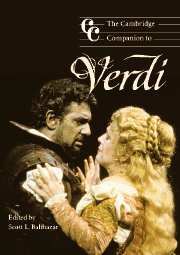Book contents
- Frontmatter
- Part I Personal, cultural, and political context
- Part II The style of Verdi's operas and non-operatic works
- 4 The forms of set pieces
- 5 Newcurrents in the libretto
- 6 Words and music
- 7 French influences
- 8 Structural coherence
- 9 Instrumental music in Verdi's operas
- 10 Verdi's non-operatic works
- Part III Representative operas
- Part IV Creation and critical reception
- Notes
- List of Verdi's works
- Select bibliography and works cited
- Index
8 - Structural coherence
from Part II - The style of Verdi's operas and non-operatic works
Published online by Cambridge University Press: 28 September 2011
- Frontmatter
- Part I Personal, cultural, and political context
- Part II The style of Verdi's operas and non-operatic works
- 4 The forms of set pieces
- 5 Newcurrents in the libretto
- 6 Words and music
- 7 French influences
- 8 Structural coherence
- 9 Instrumental music in Verdi's operas
- 10 Verdi's non-operatic works
- Part III Representative operas
- Part IV Creation and critical reception
- Notes
- List of Verdi's works
- Select bibliography and works cited
- Index
Summary
A burgeoning interest in music theory beginning in the 1960s led scholars to settle new empires, among them nineteenth-century Italian opera. Increasing sophistication of operatic analysis has been indebted to what Thomas Christensen has called “presentist” music theory, for which the craft of the critic/theorist provides a key to principles of order and value, and, by extension, an analogue to technological progress. In the early days of the academic bull market for Verdi's stock, even Pierluigi Petrobelli, a commentator not aligned to the Anglo-American theoretical establishment, observed:
Of course, we are still a long way from identifying, confidently and with absolute precision, the formal principles according to which Verdi's scores were composed and the structural laws they obey. Surely their amazing richness – testified to by our continuous rediscovery of values and meanings in these works, which have been with us for quite some time – cannot be explained in any other way than through the presence of formal principles whose determining power is directly related to, and measured by, the manifold and complex relations it establishes.
By suggesting that the “determining power” of “formal principles” is nested in a web of “complex relations,” Petrobelli posits a fertile line of investigation that seems partly to attribute the “amazing richness” of Verdi's scores to immutable laws – by implication, deeply buried and ingenious ones – waiting to be discovered by perspicacious scholars with the right tools. Is there a secret method similar to that “discovered” by Alfred Lorenz in the works of Wagner, one which will reveal the craft behind the magic?
- Type
- Chapter
- Information
- The Cambridge Companion to Verdi , pp. 139 - 153Publisher: Cambridge University PressPrint publication year: 2004
- 20
- Cited by



